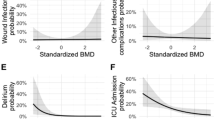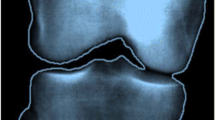Abstract
Background
Low bone mineral density (BMD) is common in older people with stroke, particularly in the paretic limb. Younger people with acquired brain injury (ABI), of all causes, are at increased risk of low BMD.
Aims
To examine prevalence of low BMD, based on World Health Organisation diagnostic criteria, in patients with ABI.
Methods
This is a cross-sectional study of 112 ABI patients. All completed a questionnaire, had laboratory investigations and DXA assessment of lumbar spine and one or both hips.
Results
Mean age ± SD of participants was 45.7 ± 13.7 years. Risk of vitamin D deficiency (25-OHD < 30 nmol/L) occurred in 27.7 %, 34.3 % had adequate levels (30–50 nmol/L) and 36.6 % had levels in excess of this. Based on T-scores, 41.1 % had osteopenia and 21.4 % had osteoporosis. A Z score of −1 or less but greater than −2 occurred in 25 %; a further 21.4 % had a Z score of −2 or less. Patients who could walk outdoors had significantly higher BMD at the neck of femur than those who walked indoors only and those who could not walk at all (p < 0.001). On multiple linear regression analysis, ambulatory ability and duration of disability were independent predictors of BMD at sound neck of femur and total proximal femur.
Conclusions
Osteopenia and osteoporosis are common in young adults with ABI compared with the general population. Bone heath monitoring should form part of the long-term follow-up of this patient group.


Similar content being viewed by others
References
Suzuki T, Sonoda S, Misawa K, Saitoh E, Shimizu Y, Kotake T (2005) Incidence and consequence of falls in in-patient rehabilitation of stroke patients. Exp Aging Res 31:457–469
Jorgensen L, Engstad T, Jacobsen BK (2002) Higher incidence of falls in long-term stroke survivors than in population controls. Stroke 33:542–547
Kanis JA (2002) Diagnosis of osteoporosis and assessment of fracture risk. Lancet 359:1929–1936
Poole KES, Compston JE (2006) Osteoporosis and its management. BMJ 333:1251–1256
Poole KES, Loveridge N, Barker PJ, Halsall DJ, Rose C, Reeve J, Warburton EA (2006) Reduced vitamin D in acute stroke. Stroke 37:243–245
Sato Y, Asoh T, Kondo I, Satoh K (2001) Vitamin D deficiency and risk of hip fractures among disabled elderly stroke patients. Stroke 32:1673–1677
Pack AM (2003) The association between anti-epileptic drugs and bone disease. Epilepsy Currents 3:91–95
Agha A, Thompson C (2005) High risk of hypogonadism after traumatic brain injury. Pituitary 8:245–249
Ramnemark A, Nilsson MM, Borssen B, Gustafson Y (2000) Stroke, a major and increasing risk factor for femoral neck fracture. Stroke 31:1572–1577
Kanis JA, Gluer C-C (2000) An update on the diagnosis and assessment of osteoporosis with densitometry. Committee of scientific advisors, International Osteoporosis Foundation. Osteoporos Int 11:192–202
Schousboe JT, Shepherd JA, Bilezikian JP, Baim S (2013) Executive summary of the 2013 ISCD position development conference on bone densitometry. jcd16:455–467
Ross AC, Manson JE, Abrams SA, Aloia JF, Brannon PM, Clinton SK, Durazo-Arvizu RA, Gallagher JC, Gallo RL, Jones G, Kovacs CS, Mayne ST, Rosen CJ, Shapses SA (2011) The 2011 Report on Dietary Reference Intakes for Calcium and Vitamin D from the Institute of Medicine: what clinicians need to know. J Clin Endocrinol Metab 96:53–58
Baim S, Wilson CR, Lewiecki EM, Luckey MM, Downs RW, Lentle BC (2005) Precision assessment and radiation safety for dual-energy X-ray absorptiometry (DXA). J Clin Densitom 8:371–378
Banham-Hall J, Kothwal K, Pipkin J, Bentley J, Dickens GL (2013) Prevalence of low bone mineral density in inpatients with traumatic brain injury receiving neurobehavioural rehabilitation; a post-operative observational study. Physiotherapy 99:328–334
Pang MYC, Eng JJ, McKay HA, Dawson AS (2005) Reduced hip bone mineral density is related to physical fitness and leg lean mass in ambulatory individuals with chronic stroke. Osteoporosis Int 16:1769–1779
Watanabe Y (2004) An assessment of osteoporosis in stroke patients on rehabilitation admission. Int J Rehabil Res 27:163–166
Dennison E, Cole Z, Cooper C (2005) Diagnosis and epidemiology of osteoporosis. Curr Opin Rheumatol 17:456–461
Beaupre GS, Lew HL (2006) Bone density changes after stroke. Am J Phys Med Rehabil 85:464–472
Demirbag D, Ozdemir F, Kokino S, Berkarda S (2005) The relationship between bone mineral density and immobilisation duration in hemiplegic limbs. Ann Nuc Med 19:695–700
Jorgensen L, Crabtree NJ, Reeve J, Jacobsen BK (2000) Ambulatory level and asymmetrical weight bearing after stroke affects bone loss in the upper and lower part of the femoral neck differently: bone adaptation after decreased mechanical loading. Bone 27:701–707
Jorgensen L, Jacobsen BK (2001) Functional status of the paretic arm affects the loss of bone mineral in the proximal humerus after stroke: a 1-year prospective study. Calcif Tissue Int 68:11–15
Jorgensen L, Jacobsen BK, Wilsgaard T, Magnus JH (2000) Walking after stroke: does it matter? Changes in bone mineral density within the first 12 months after stroke, A longitudinal study. Osteoporosis Int 11:381–387
Pang MYC, Eng JJ (2005) Muscle strength is a determinant of bone mineral content in the hemiparetic upper extremity: implications for stroke rehabilitation. Bone 37:103–111
Worthen LC, Kim CM, Kautz SA, Lew HL, Kiratli BJ, Beaupre GS (2005) Key characteristics of walking correlate with bone density in individuals with chronic stroke. J Rehabil Res Dev 42:761–768
del Puente A, Pappone N, Mandes MG, Mantova D, Scrpa R, Oriente P (1996) Determinants of bone mineral density in immobilisation: a study on hemiplegic patients. Osteoporosis Int 6:50–54
Cashman KD, Muldowney S, McNulty B, Nugent A, FitzGerald AP, Kiely M, Walton J, Gibney MJ, Flynn A (2013) Vitamin D status of Irish adults: findings from the National Adult Nutrition Survey. Br J Nutr 109:1248–1256
Sato Y, Kuno H, Asoh T, Honda Y, Oizumi K (1999) Effect of immobilisation on vitamin D status and bone mass in chronically hospitalised disabled stroke patients. Age Ageing 28:265–269
Iwamoto J, Tsukimura T, Takeda T (1999) Bone mineral density of metatarsus in hemiplegic subjects. Am J Phys Med Rehabil 78:202–207
Takamoto S, Masuyama T, Nakajima M, Sekiya K, Kosaka H, Morimoto S, Ogihara T, Onishi T (1995) Alterations of bone mineral density of the femurs in hemiplegia. Calcif Tissue Int 56:259–262
Jorgensen L, Jacobsen BK (2001) Changes in muscle mass, fat mass and bone mineral content in the legs after stroke: a 1 year prospective study. Bone 28:655–659
Jorgensen L, Joakimsen O, Rosvold Berntsen GK, Heuch I, Jacobsen BK (2004) Low bone mineral density is related to echogenic carotid artery plaques: a population based study. Am J Epidemiol 160:549–556
Schulz E, Arfai K, Liu X, Sayre J, Gilsanz V (2004) Aortic calcification and the risk of osteoporosis and fractures. J Clin Endocrinol Metab 89:4246–4253
Author information
Authors and Affiliations
Corresponding author
Ethics declarations
Funding
This study was funded by the National Medical Rehabilitation Trust Ltd. (There is no research grant number).
Conflict of interest
Dr. Éimear Smith declares she has no conflict of interest. Dr. Catherine Comiskey declares she has no conflict of interest. Dr. Áine Carroll declares she has no conflict of interest.
Ethical standards
All procedures performed in this study, involving human participants, were in accordance with the ethical standards of the NRH ethics committee and with the 1964 Helsinki declaration and its later amendments or comparable ethical standards.
Rights and permissions
About this article
Cite this article
Smith, É., Comiskey, C. & Carroll, Á. Prevalence of and risk factors for osteoporosis in adults with acquired brain injury. Ir J Med Sci 185, 473–481 (2016). https://doi.org/10.1007/s11845-016-1399-5
Received:
Accepted:
Published:
Issue Date:
DOI: https://doi.org/10.1007/s11845-016-1399-5




